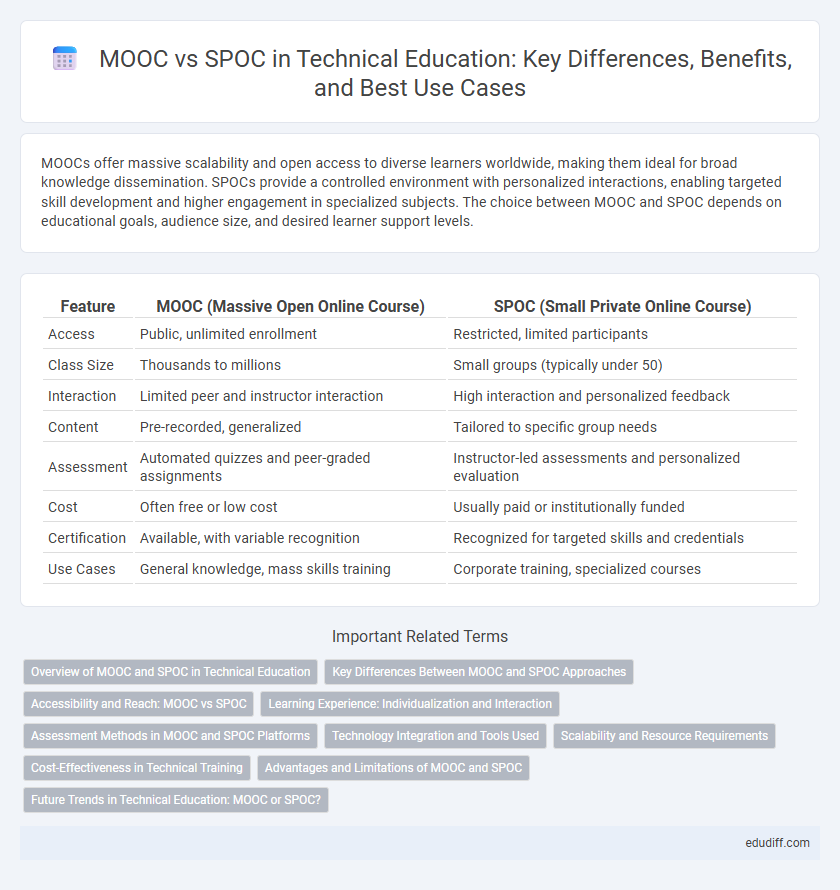MOOCs offer massive scalability and open access to diverse learners worldwide, making them ideal for broad knowledge dissemination. SPOCs provide a controlled environment with personalized interactions, enabling targeted skill development and higher engagement in specialized subjects. The choice between MOOC and SPOC depends on educational goals, audience size, and desired learner support levels.
Table of Comparison
| Feature | MOOC (Massive Open Online Course) | SPOC (Small Private Online Course) |
|---|---|---|
| Access | Public, unlimited enrollment | Restricted, limited participants |
| Class Size | Thousands to millions | Small groups (typically under 50) |
| Interaction | Limited peer and instructor interaction | High interaction and personalized feedback |
| Content | Pre-recorded, generalized | Tailored to specific group needs |
| Assessment | Automated quizzes and peer-graded assignments | Instructor-led assessments and personalized evaluation |
| Cost | Often free or low cost | Usually paid or institutionally funded |
| Certification | Available, with variable recognition | Recognized for targeted skills and credentials |
| Use Cases | General knowledge, mass skills training | Corporate training, specialized courses |
Overview of MOOC and SPOC in Technical Education
Massive Open Online Courses (MOOCs) provide scalable access to diverse technical education topics, offering video lectures, quizzes, and peer interactions to thousands of learners globally. Small Private Online Courses (SPOCs) focus on restricted, smaller groups, enabling personalized feedback, enhanced interaction, and customized content tailored for specific technical skill development. Both MOOC and SPOC platforms leverage digital tools to improve accessibility and flexibility in technical education, but SPOCs emphasize deeper engagement and hands-on learning experiences.
Key Differences Between MOOC and SPOC Approaches
MOOCs (Massive Open Online Courses) provide open access to unlimited participants worldwide, promoting broad scalability and diverse interaction, while SPOCs (Small Private Online Courses) cater to a limited, specific group, enabling personalized learning experiences and greater instructor-student engagement. MOOCs emphasize flexibility and wide accessibility, often lacking tailored feedback mechanisms, whereas SPOCs offer structured curricula with targeted assessment and more rigorous monitoring of learner progress. The choice between MOOC and SPOC approaches depends on educational goals, with MOOCs suited for mass knowledge dissemination and SPOCs ideal for intensive, customized training programs.
Accessibility and Reach: MOOC vs SPOC
Massive Open Online Courses (MOOCs) offer unparalleled accessibility by providing free or low-cost education to millions globally, leveraging internet connectivity to reach diverse populations regardless of geographic location. In contrast, Small Private Online Courses (SPOCs) target a limited audience, often linked to specific institutions or organizations, which restricts their reach but enhances personalized interaction and tailored content. The scalability of MOOCs drives broad knowledge dissemination, while SPOCs emphasize controlled environments that improve engagement and learning outcomes for enrolled participants.
Learning Experience: Individualization and Interaction
SPOCs offer a highly personalized learning experience by enabling tailored content and real-time interaction between instructors and students, which enhances engagement and knowledge retention. MOOCs typically serve larger, more diverse audiences with less direct interaction, relying on peer forums and automated assessments for feedback. The individualization and immediate instructor support in SPOCs lead to more effective skill development compared to the broader, less personalized approach of MOOCs.
Assessment Methods in MOOC and SPOC Platforms
Assessment methods in MOOC platforms typically emphasize automated quizzes, peer reviews, and project-based evaluations to manage large, diverse learner populations efficiently. SPOC platforms adopt more personalized assessment strategies, including instructor-graded assignments, real-time feedback, and interactive assessments tailored to smaller, focused cohorts. The integration of formative and summative assessments in SPOCs enhances learner engagement and mastery compared to the scalability-driven approaches in MOOCs.
Technology Integration and Tools Used
MOOCs leverage scalable platforms like Coursera and edX, utilizing video lectures, forums, and automated assessments powered by cloud computing and AI to support massive learner engagement. SPOCs integrate more personalized technology such as LMS platforms like Moodle or Blackboard, incorporating interactive tools like real-time quizzes, breakout rooms, and adaptive learning analytics for targeted instruction. Both formats use APIs and data analytics to track learner progress, but SPOCs emphasize synchronous technology integration for enhanced learner-instructor interaction.
Scalability and Resource Requirements
MOOCs (Massive Open Online Courses) offer unparalleled scalability by enabling thousands of learners to access content simultaneously, requiring minimal incremental resources per user due to automated delivery. SPOCs (Small Private Online Courses) demand higher resource allocation per student because of personalized interactions and limited enrollment, which enhances engagement but restricts scalability. Efficient implementation of MOOCs hinges on robust digital infrastructure, while SPOCs rely more on dedicated instructional support and smaller cohort management.
Cost-Effectiveness in Technical Training
SPOCs (Small Private Online Courses) offer higher cost-effectiveness in technical training by delivering personalized content to smaller groups, reducing the need for large-scale infrastructure. MOOCs (Massive Open Online Courses) provide extensive reach and low per-learner cost but often lack the tailored interaction critical for complex technical skills. Organizations seeking efficient skill development balance SPOC customization benefits against MOOC scalability when optimizing training budgets.
Advantages and Limitations of MOOC and SPOC
MOOCs offer scalable access to diverse content for thousands of learners worldwide, promoting flexibility and cost-effectiveness but often lack personalized interaction and lower completion rates. SPOCs provide a controlled learning environment with targeted content and greater instructor engagement, enhancing comprehension and motivation, yet they require limited enrollment and higher resource investment. Both formats play complementary roles in online education, balancing accessibility with depth of learning experience.
Future Trends in Technical Education: MOOC or SPOC?
Future trends in technical education demonstrate a growing preference for SPOCs (Small Private Online Courses) due to their ability to offer personalized learning experiences and enhanced interaction with instructors, addressing the limitations of traditional MOOCs (Massive Open Online Courses). The integration of AI-driven analytics in SPOCs enables adaptive learning paths, improving knowledge retention and skill acquisition critical for emerging technologies like AI, blockchain, and cybersecurity. As industry demands evolve, SPOCs facilitate targeted upskilling and continuous professional development, making them a strategic choice over MOOCs for technical education.
MOOC vs SPOC Infographic

 edudiff.com
edudiff.com